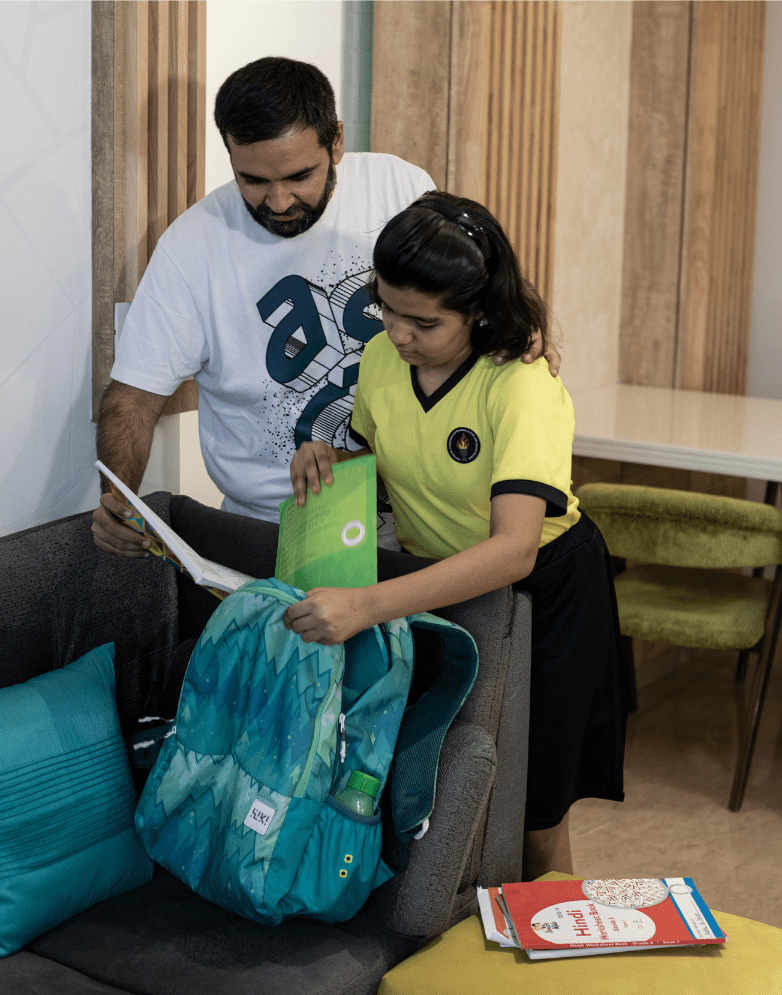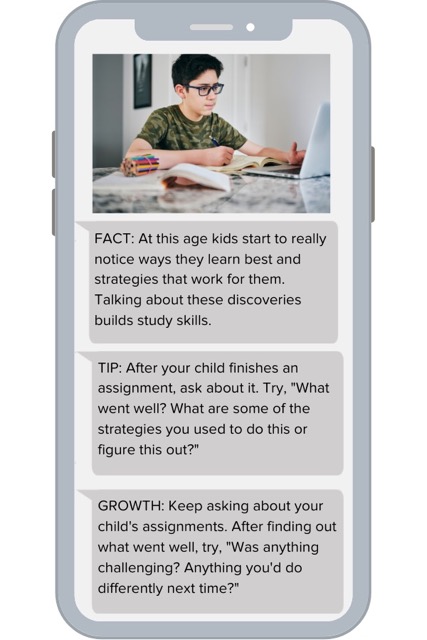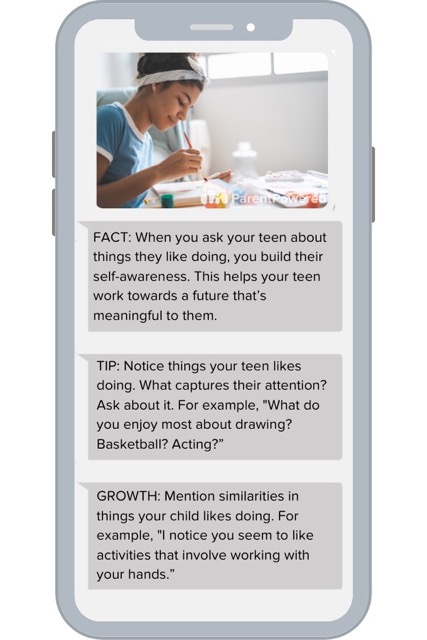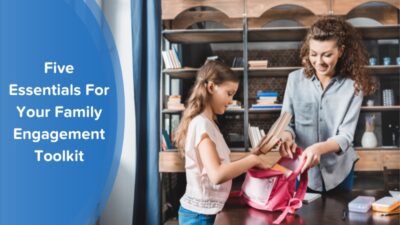By Rebecca Honig, chief content and curriculum officer; edited by Maren Madalyn
When my first child went to elementary school, I basically went with her. I mean, I didn’t enroll officially, but there were enough PTA meetings, classroom volunteer opportunities, conferences, concerts, family nights, and field trips to give me the general sense that I was traveling through each grade right along with her. Parental involvement programs abounded.
And then came the end of elementary school, and what I assumed would be a minor shift for parents like me into adolescent family engagement. Little did I know the challenge that nearly every parent of a pre-teen faces during this crucial transition period into secondary school.
To this day, I remember that final parent night of my daughter’s elementary school tenure. We were there to talk about “the stepping up ceremony” in which our kids would venture off to middle school. We were just wrapping up a discussion of “should we celebrate with cake or fruit salad?” when one mother came up to me and gave me a big emotional hug. “Bye,” she said as tears welled in her eyes.
“Oh. Where are you going?” I asked, assuming with a goodbye like that she must be moving between school districts or even cities.
“I’m not going anywhere” she clarified, “But you know… Middle School.”

At the time, I was confused. Our children’s middle school was just across the street. You could literally see it from the window. “Won’t I still see you?” I asked, “You know… at all the school events? At the meetings? At the conferences?”
She just shook her head real slowly in this “Oh honey” sort of way. Like she was about to break the news about the Tooth Fairy to a child who’d gone on believing for a little too long. And then she explained. “As someone who has two kids in middle school, I can confidently say that parental engagement is NOT a thing in middle school”.
And then she really spelled it out for me. “You can’t even go in that building. There’s no walking your child into school. You basically shove them out of the car without taking your foot off the gas.”

The mystery of middle school family engagement
My response was to immediately start phoning friends across the country, hoping to find a different narrative that I could latch on to. Surely, someone had found an inroad to middle school family engagement! But the answers they shared were, well, not exactly inspiring.
A friend in California shared that if she drove past the school around 8:03, she could usually spot the back of her daughters’ head through a window in the ELA classroom. This sharply differed from our days in elementary school, where parents in the classroom was a common form of family and school collaboration.
A friend in Ohio offered that she found the grocery store was the best place to bump into her sons’ Math teacher. And that she had once followed him down the frozen foods section trying to work up the courage to ask about algebra homework. This wasn’t at all like the parent-teacher relationships we experienced in elementary school.
Beyond these insights, I came up empty handed. No matter where they were from — big cities, suburbs, rural communities — every parent expressed the same sentiment: “Parent engagement in middle school??? What?!?”
I walked away with a whole new picture in my head of my role as a parent in my daughter’s upcoming experience.
But here’s the good news: middle school family engagement is not a myth (though it may certainly feel like a mystery for families, teachers, and school principals). There is so much research about the power of adolescent family engagement, which ParentPowered used to guide developing a family engagement curriculum specifically for families of middle schoolers. These studies indicate that middle school educators need to build positive partnerships with their families to in turn build a positive school climate. Better still, there are evidence-based ways to cultivate parent involvement in education during adolescence.
So let’s demystify adolescent family engagement in schools!
Families struggle with finding a way into adolescent learning
First, we have to understand — and this comes at no surprise — that families have a hard time finding inroads into middle school learning. Research tells us that families face a whole new host of challenges when kids transition to these critical years of development. This is in addition to the most common hurdles to parent involvement in school, like limited time, limited access to information and language and cultural barriers.
For example, let’s explore the key challenge of understanding middle school itself. As Nancy Hill and Diana Tyson summarize in their insightful article, Parental Involvement in Middle School, “middle schools are large and complex, often making it difficult for parents to figure out how to become effectively involved.”
Instead of one teacher serving as home base for most subjects, middle school is departmentalized. Kids travel from room to room and teacher to teacher for every academic subject. This makes it hard for parents to know who to contact for insight into their child’s learning and support with their involvement in education.
“Family engagement improves classroom dynamics and increases teacher expectations, student–teacher relationships, and cultural competence, regardless of students’ age groups.”
Boberiene, Liepa V.
American Journal of Orthopsychiatry, Vol 83(2-3), Apr-Jul 2013, 346-351
I had to make a little spreadsheet reminding myself of which teacher taught what subject, just so I could follow along when my daughter was telling me about her day. And that one parent-teacher conference I went to felt like speed dating. I arrived in a room where five teachers were lined up at desks, and I was allotted three minutes to chat with each of them. This whirlwind tour made it really hard to get the Big Picture on my child’s strengths and areas for growth, let alone cultivate parent-teacher relationships.
Looking further, research also tells us that “many families, particularly those from special populations, have had a negative experience with school themselves, which reduces the likelihood of their initiating engagement with their child’s school without intentional strategies on the teachers’ side to engage families.” (Hindman et al., 2012) Though this reluctance can also impact younger students, it is especially important for middle school, where designing parental involvement programs feels hard enough for educators.
Adding complexity here is middle school students’ growing desire for independence that comes with adolescence. It’s a time when kids want their space. Pre-teens especially “want to be trusted that they will manage their responsibilities. That is, adolescents often indicate that they want their parents’ help but do not want their parents to visit the school.” (Hill & Tyson, 2009)
Meanwhile, in elementary school, I practically had to peel my daughter off of me at the start of school. If I came into her class to read a book or help with a craft, she celebrated like it was a national holiday. Compare that reaction to the one time I tried to follow her into the middle school building. She threw herself against the door and hissed, “If you take one step into this building I will literally NEVER forgive you. EVER!” I just needed to ask her advisor one question. Imagine if I tried volunteering in any of her classrooms!
To top all that off, many of the concepts kids are learning in older grades are… well, I’ll just speak for myself, beyond me.
To top all that off, many of the concepts kids are learning in older grades are… well, I’ll just speak for myself, beyond me.
Case in point: how many parents would be comfortable guiding their adolescents in “using the equation of a linear model to solve problems in the context of bivariate measurement data, interpreting the slope and intercept.” CCSS.Math.Content.8.SPA.3. And that’s just a middle school math standard.

All the factors above run the risk of families reaching this crux point: “The older the child becomes, the more disconnected families feel from the school community and the more unsupported by the school and community.” (Kelty & Wakabayashi, 2020)
But adolescent family engagement matters. A lot.
But here’s the thing that every educator knows: when families ARE engaged in school, the educational outcomes are tremendous. This is true for every grade and every student age group. Family involvement in education at every level is essential.
For starters, positive family relationships with schools contributes to a positive school climate. As Kelty and Wakabayashi cite, “family engagement improves classroom dynamics and increases teacher expectations, student–teacher relationships, and cultural competence, regardless of students’ age groups.”
And in their meta-analysis of family engagement research, Family Involvement In Middle and High school Students’ Education, the Harvard Family Research Project summarized a wide variety of adolescent learning outcomes that improved through family engagement, including but not limited to:
- Higher rates of self-reliance
- Better school performance
- Positive career-planning
- Lower rates of depression
“Youth who share trusting relationships with their parents—characterized by mutual and sustained bonds and open communication—have higher grade point averages (GPAs) and better physical health and are more likely to disclose information to their parents that will keep them out of trouble.”
Harvard Family Research Project
Additionally, the development of children during adolescence basically necessitates continued parental support when it comes to social and emotional learning. Families play a critical role during this time with children to help them to practice healthy behaviors, use effective communication, and navigate relationships more successfully.
Research also tells us that adolescents in particular face unique mental health challenges. Many types of mental illness, such as anxiety and bipolar disorder, show themselves for the first time during adolescence. This makes family outreach and engagement both with their children and with their schools extra important.
What about families? What are their desires when it comes to engagement in schools? Do they even want to be involved in middle school learning? Absolutely! Research shows that families want to be included and to support both the development of children as well as their education in secondary school. This eagerness for a positive relationship with schools holds true regardless of a family’s cultural background or other demographics.
In short, it’s clear that adolescent family engagement drives hugely positive effects for middle school learning.
Though this is excellent news for middle school principals and teachers, educators still need to be exceptionally thoughtful in how they cultivate middle school family relationships. It isn’t the same kind of partnership as seen in elementary school communities. And it shouldn’t be. Adolescent learners have quite different needs, but that doesn’t preclude parents from playing a critical role in the learning development of children in middle school.

Evidence-based strategies for adolescent family engagement
When designing our middle school family engagement curricula, the ParentPowered team knew that we needed to leverage those common elements shared in successful family engagement programs. But we also needed to evolve learning strategies for parents to match the development happening within those adolescent years. After all, we all know (and likely can remember from our own middle school years) that 6th grade is not the same as 8th grade.
To demystify effective adolescent family engagement, let’s unpack a few examples of those key factors that make the middle school adjustment and learning journey so unique — and what educators can do to support families to honor these changes.
Navigating new social challenges
In elementary school, a tremendous amount of social development takes place. From kindergarten through fifth or sixth grade, kids continue building and refining fundamental relationship skills. It starts in the early elementary grades with things like recognizing differences in opinions or experiences among their peers, and identifying positive, unique traits in others. They build stronger self-awareness and improve their ability to specifically describe others’ perspectives and how they may differ from their own thoughts.
But middle school socialization is on a whole other level of nuance. It’s here that students find themselves in the tense balance of both wanting to fit in and find a sense of belonging among their peers — while also forming their own self-identity and independence. Skills like responsible decision making are crucial to help kids navigate the ups and downs of friendship and sometimes even family relationships.

In kind, a parent’s role in supporting their child’s social and emotional development must also shift. Sometimes, this change can be downright scary. But the good news is that, even as their pre-teen looks for ways to be more independent and autonomous, parents can still help them prepare for all sorts of social situations in a safe environment.
Here’s how ParentPowered offers support to families of middle schoolers when it comes to navigating friendship and preparing for common challenges:
- FACT: In middle school, kids feel a strong desire to fit in. Talking about social situations before they happen helps kids make healthy choices.
- TIP: Ask questions to help your child think about social situations. Try, “What can you do or say if a friend asks you to do something you don’t want to do?”
- GROWTH: Keep talking. Brainstorm things your child might say to get out of an uncomfortable situation. For example, “No thanks, I’m not into that.”
Check out our recent article for more social emotional learning activities for middle school specifically geared towards supporting positive student behaviors, social skills, and emotional development.
Practicing academic socialization
While research shows the importance of direct parent involvement in education during the early years of school, this same level of engagement in schools is not necessarily helpful for adolescents. In fact, studies have found that this type of academic involvement in homework can actually negatively impact student achievement (Cooper, 1989, 2007; Wolf, 1979).
So how do middle school families positively impact their child’s academic learning, if not directly?
The answer lies in academic socialization — “how parents use their own educational beliefs and expectations to provide messages to their children to help navigate or influence their academic success and development” (Hill & Tyson, 2009).
This approach is much more effective for positive adolescent family engagement, even leading to positive effects such as boosted academic performance in older grades.

Here’s one way that ParentPowered encourages families to practice academic socialization with their pre-teens at home and ease away from direct academic involvement in education:
- FACT: When you say positive things about school, your child feels even more invested in learning. It’s a key way to help them thrive in middle school.
- TIP: As your child finishes homework, mention how skills you built in school have helped you in life. Have they helped you land jobs? Make friends?
- GROWTH: Ask about jobs your child wants to do someday. Help them notice ways the skills they’re learning in school will help them do this work.

Shifting family mindsets around adolescence
Let’s face it, adolescence has a tricky reputation among some families. I’ve overheard many elementary parents express dread about their child’s inevitable ascent into middle school, fearing mood swings, rebellious behavior, and other “terrible consequences”.
Such family attitudes towards middle school are exactly the ones that ParentPowered wants to help shift in middle school families. By arming parents with insight about adolescent development, educators can also give families ways to celebrate all the good that comes in middle school. There is so much to celebrate! This knowledge can work wonders for families of children navigating the changes that come with the middle school adjustment process.
In addition to offering families ways to impact their pre-teen’s academic work and social skills development, our curriculum also includes strategies for parent self care. For middle school parents in particular, these activities aim to boost their confidence, help them practice stress management skills, and expose them to ways they can care for their own mental health.
And parental well-being is one of several key factors that can help families navigate this essential time with children in middle school.

In addition to offering families ways to impact their pre-teen’s academic work and social skills development, our curriculum also includes self-care strategies. For middle school parents in particular, these activities aim to boost their confidence, help them practice stress management skills, and expose them to ways they can care for their own mental health. And parental well-being is one of several key factors that can help families navigate this essential time with children in middle school.
Here’s one of our favorite examples of a self-care tip for middle school parents:
- FACT: Doing things for yourself (no matter how small) can have a HUGE impact on your well-being. Just noticing these “feel good things” really helps ensure you’ll keep doing them.
- TIP: Today, think about the things you do that make you feel strong and confident. Is it exercise? Talking with others? Listening to music? These “feel good things” can be a source of strength every day!
- GROWTH: Keep noticing what else you need to feel strong and ready for the day. Make a list of easy, doable things that make you feel good. Try one thing from the list out. How did it feel? Is it something you can do daily?
These are just a few of the many ways in which families can truly make a positive difference in their pre-teen and teen’s learning journeys. If you’re ready to dive straight into adolescent family engagement in your organization, or just want to learn more about what makes parental involvement programs effective in middle school, we’d love to hear from you!
Adolescent family engagement is a game-changer for middle school!
Family engagement in middle school may feel mysterious at times, but it has so much to offer school communities. Both educators and students benefit from families’ engagement in schools during these crucial years. Through things like reciprocal home-school communication and support during the middle school adjustment period after elementary school, educators harness the power of their community to build a positive school climate and healthy learning environment for all students.
Strategies to build family-school partnerships may look quite different as students graduate from elementary school, and that’s OK! Just as students shift into new relationships, social experiences, and academic challenges — so too do families shift their role in their children’s learning journeys. With effective family and school collaboration, everyone creates the best opportunity for a middle school student to thrive.

About the author
Rebecca Honig is the Chief Content and Curriculum Officer at ParentPowered. She has authored numerous curricula, parent guides, and children’s storybooks for Sesame Workshop, Scholastic, Disney, Compass Learning, PBS, WGBH, HITN, Nickelodeon, Mo Willems, and The Norman Rockwell Museum. She has also served as a Curriculum and Content Specialist for Sesame Street and spent ten years teaching in public, private, and after school programs. Rebecca has a Master’s Degree in Early Childhood Education from Bank Street.





